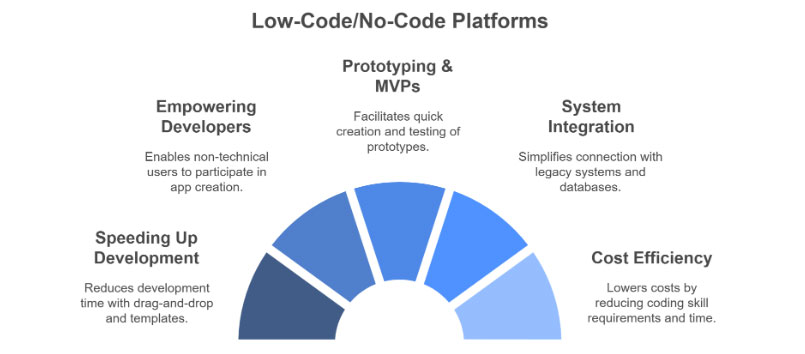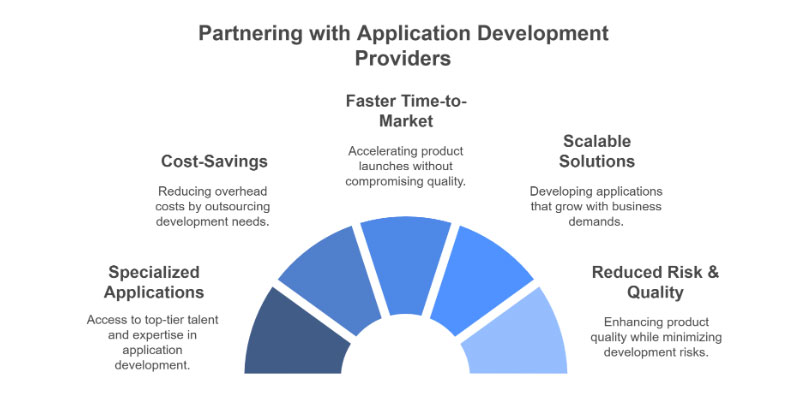- January 20, 2025
Low-Code vs No-Code - Choosing the Perfect Fit for Business Transformation
Have you known how much the low-code and no-code development market is expected to reach by 2027?
Experts say it’s going to reach staggering heights of $187 Billion! Of course that’s a huge number.
With the increasing demand for faster and more cost-effective application development services from businesses, low-code and no-code platforms are a game-changer for SMBs and enterprises alike.
But what exactly are low-code and no-code platforms, and how do they differ? Both approaches help simplify application development by empowering users technically or non-technically to build applications faster without making heavy use of traditional coding.
For businesses, especially those with limited IT resources, these platforms could accelerate digital transformation, optimize workflows, and drive innovation without overextending the budget or timeline.
Find out the differences between low-code and no-code development, their pros and cons, and how to decide which best fits your business needs. Be it an SMB looking to modernize operations or an enterprise in pursuit of agility, this guide will help navigate what’s right for you.
Let’s get started!!
Understanding Application Development Services
In recent years, application development services have taken a paradigm shift evolving from traditional coding practices into a low-code and no-code approach.
Low-code and no-code platforms fit well with the larger Application Development Ecosystem and have developed into a much stronger tool with high development capabilities that do not depend on major coding skills extensively.
- Simplifying Complex Processes: Low-code and no-code platforms enable developers and even non-technical users to quickly build functional applications. They assist traditional application development services by dealing with repetitive work and streamlining workflows through drag-and-drop interfaces and pre-built templates.
- Enhancing Collaboration: Using low-code & No-code enables cross-functional teams to participate in application development without requiring extensive technical expertise. This democratization of development encourages innovation and accelerates delivery.
- Accelerating Time-to-Market: In contrast to traditional coding which takes time, low-code and no-code alternatives allow for faster iterations and deployment. With reduced turnaround times on the application development services provided, businesses can respond rapidly to market needs.
- Cost-Effective Solutions: From a budget-friendly point of view, low-code/no-code platforms can save organizations money because the amount of dollars that are normally spent on coding skills is reduced due to less reliance on specialized knowledge. They are seamlessly integrated into existing application development services which allow for scalability without the high fees.
Low-code and no-code are not a replacement for traditional application development, they are an enhancement. Combining these platforms with comprehensive application developer services empower organizations to leverage an unprecedented balance of speed, scale, and creativity that changes the development and delivery process altogether.
What is Low-Code Development?
Low-code application development is a visual approach that enables users to create applications through simple visual tools using drag-and-drop components and minimal hand-coding.
It enables developers to rapidly create and deploy applications by simplifying the intricacies of conventional coding. It’s great for organizations wanting to fast track processes while still being able to tailor products.
With low-code platforms, developers can seamlessly integrate multiple systems, automate functions, and deliver high-scale solutions in record time.
What is No-Code Development?
No-code application development goes a level beyond that, allowing non-technical users to build functional applications. No-code platforms do not require writing any code by using intuitive visual tools.
This paves more grounds to democratize application development services, whereby business users can create apps for specialized tasks and automated processes to boost productivity without relying heavily on IT teams.
No-code is ideal for companies that want fast, cost-effective solutions that drive innovation throughout their wider organization.
Low-Code vs No-Code vs Traditional Development – A Comparison Table
| Aspect | Low-Code | No-Code | Traditional Development |
|---|---|---|---|
| Definition | Development platforms with minimal coding, using drag-and-drop components and pre-built templates. | Platforms for creating apps without any coding, aimed at non-developers. | Building applications manually using programming languages and frameworks. |
| Target Users | Developers and tech-savvy business users. | Non-developers, business analysts, and citizen developers. | Professional software developers. |
| Skill Requirement | Basic coding knowledge. | No coding skills required. | Advanced programming skills are mandatory. |
| Speed of Development | Fast, as templates and reusable components reduce coding effort. | Very fast, as there is no need for coding. | Slow, as it requires writing code from scratch. |
| Customization | Moderate; some coding flexibility allows deeper customization. | Limited; customization options are constrained to pre-built tools. | High; complete control over every feature and functionality. |
| Scalability | Suitable for mid-level scalability; may require traditional coding for complex use cases. | Limited scalability, best for small-scale applications. | Highly scalable, suitable for enterprise-grade solutions. |
| Use Cases | Automating workflows, creating business apps, and MVPs. | Simple apps like forms, dashboards, and single-function tools. | Complex and highly customized enterprise applications. |
| Cost | Cost-effective with reduced development time and resource usage. | Low cost; ideal for small budgets and quick deployment. | Higher cost due to extensive development time and resources. |
| Integration | Supports integration but may have limitations. | Limited integration capabilities. | Highly flexible with integration options. |
| Maintenance | Easier to maintain but relies on the platform's updates. | Extremely easy, managed entirely by the platform provider. | Requires ongoing effort and resources for updates and bug fixes. |
| Examples | Microsoft Power Apps, OutSystems, Mendix. | Wix, Bubble, AppGyver. | Custom-built applications with Java, Python, or C#. |
Low-Code and No-Code platforms cater to different user groups by simplifying the development experience, while traditional development is best suited for highly complex and customized applications.
How Does Low-Code and No-Code Fit into Application Development Services?

Low-code and no-code platforms have integrated so well into the application development process and redefined the way companies develop, build, and deploy software products that it is difficult to imagine developing without them.
These platforms and here is how they relate to and improve the modern development environment:
- Speeding Up Development Cycles: So, low-code and no-code tools really change the scenario, you know? They cut down the time it takes to whip up applications, thanks to things like drag-and-drop interfaces, templates that are already made for you, and these modular bits you can mix and match. Developers? Well, they get to zero in on tweaking the features instead of starting from square one, which is better.
- Empowering Everyday Developers: Here’s the coolest part, these platforms open the door for folks who aren't tech wizards, like business analysts or managers, to jump in and help create apps. It’s like leveling the playing field! This shift means less reliance on IT teams and sparks a whole lot of teamwork and creativity.
- Boosting Prototyping and MVP Creation: Low-code and no-code solutions are simply perfect for whipping up prototypes or Minimum Viable Products (MVPs) in no time flat. It really helps in testing out ideas quickly and getting user feedback right at the start, which is significant, right?
- Connecting with Existing Systems: These days, low-code and no-code platforms are impressive with their API integrations. It’s like they make it super straightforward to link up new applications with those old legacy systems, databases, and even other services out there. This really helps keep everything running smoothly, which is a big plus.
- Boosting Agile Development: And speaking of smooth, these platforms totally fit the bill for agile development. They allow teams to make quick changes, roll out updates often, and constantly improve things based on what users say and what the market demands. It’s all about being flexible, right?
- Cutting Down on Costs: Plus, they make a significant change when it comes to saving costs. By cutting back on the need for deep coding skills and speeding up development times, organizations can really stretch their budgets and still pump out high-quality applications.
- Encouraging Innovation for Specific Needs: Finally, let’s not forget how these tools can spark innovation for those unique business needs. Whether it’s automating workflows, creating data visualization dashboards, or producing tools to engage customers, low-code and no-code solutions make it all happen quickly without needing a ton of IT help.
Choosing the Right Path: When to Use Low-Code, No-Code, or Traditional Development
Low-Code Application Development:
Best for: Well, if a business needs custom applications that aren’t too complex but still want things done quickly and with less coding, this will be very apt
When to use it:
- Custom application development or solution that plays nicely with existing systems or databases.
- When the team knows very minimal technology but could really use a boost in getting things done faster.
- While looking to add some specific features that no-code platforms just can’t handle.
- To decrease the load on your IT team while keeping some customization in the mix.
Benefits:
- Flexibility compared to no-code platforms when it comes to custom workflows and integrations.
- It’s quicker than the old-school development methods, especially for enterprise-level applications.
- Get used to that sweet spot between being user-friendly and having advanced capabilities, which empowers both business users and developers. How great is that?
So, concisely, low-code development is a smart choice for businesses looking to innovate without getting bogged down in complicated coding.
No-Code Application Development
Best for: Quick application creation with little technical fuss—perfect for folks who aren’t really into coding.
Use When:
- Developing basic apps or workflows that are straightforward.
- When the team doesn’t exactly possess proven skills in coding but needs to create stuff for business, like forms, dashboards, or simple databases.
- When the project isn’t too complicated and can be tackled with pre-made components or templates.
- Speed matters a lot, and you need accelerate time-to-market without waiting for developers.
Benefits:
- Great for prototyping, MVPs, or smaller projects that don’t need a ton of custom features.
- It really cuts down on both time and costs for development, especially for teams that aren’t tech-savvy.
- With user-friendly drag-and-drop interfaces, you can build things fast, no coding needed.
Now, let’s talk about Traditional Development!
Best for: When you’re diving into complex, high-performance applications that need to be scalable and secure, plus you want total control over features and customization.
Use When:
- Craft highly customized applications that need specific algorithms, integrations, or functionalities.
- If your organization has tech experts who can handle the practical details of code-heavy development.
- The app needs to be super secure, scalable, and easy to maintain down the line.
- The project calls for full flexibility and control over everything, from infrastructure to backend systems and APIs.
Benefits:
- Get complete authority over every little detail of the application, both front and back end.
- Create complex, enterprise-level applications with all sorts of intricate logic and specialized features.
- Greater scalability, flexibility, and long-term viability, especially for larger applications.
Benefits of Partnering with Application Development Service Provider

Teaming up with an application development service provider can really help businesses tap into the expertise and resources they need. It’s all about flexibility, too! When you want to create top-notch, scalable apps that fit your goals perfectly, this partnership can be a significant change.
So, whether you’re thinking about building custom software, migrating those old legacy systems, or just wanting to give your current applications a little boost, working with a dedicated service can offer some pretty great benefits.
Here’s a look at how it can work out for you:
1. Access to Specialized Applications
Why does it matter: Well, application development is not for all. It often calls for skills that might be hard to find within your own team. That’s where application development service providers come into play.
They have a whole squad of seasoned developers, architects, and project managers. These folks know their stuff when it comes to the latest tech and best practices out there.
Benefits: By teaming up with a provider, businesses get access to top-notch talent without the need to bring on full-time employees. This way, your team can keep their focus where it really matters on the core activities that drive your business forward. Sounds good, doesn’t it?
2. Cost-Savings
Why does it matter: Creating and keeping an in-house application development team can really add up. We’re talking about salaries, training costs, and all that infrastructure, it can get pretty pricey.
Benefits: When teamed up with Application development service providers, businesses can actually cut down on those overhead expenses. They only pay for what they really need, and only when they need it.
This way, organizations can make the budget work better and, honestly, allocate their resources in a smarter way. It’s all about efficiency!
3. Faster Time-to-Market:
Why does it matter: In this competitive world, faster time-to-market is important? If you delay your product launch, you might miss excellent opportunities or, worse, find yourself behind your rivals.
Benefits: Application development service providers can really help. They use agile methods and have tons of experience up their sleeves. This means they can speed up the whole development process for you.
The best part? You won’t have to sacrifice quality for that quicker turnaround. Sounds pretty good, right?
4. Scalable Solutions
Why does it matter: As your business expands, the demands on your applications increase as well. Scaling your current systems internally can be complicated and require significant resources.
Benefits: A service provider can develop scalable applications from the outset or assist in scaling your existing systems to adapt to changing business requirements, ensuring your solutions can evolve alongside your growth.
5. Reduced Risk & Improved Quality
Why does it matter: Managing and developing applications can take a lot of time, pulling your internal teams away from their core business activities affects productivity. Application service providers can step in and reduce risks with improved quality products.
Benefits: Outsourcing application development allows your team to concentrate on strategic initiatives while entrusting the technical work to specialists.
6. Ongoing Maintenance & Support
Why does it matter: After deployment, applications require ongoing updates, security patches, and troubleshooting to maintain optimal performance.
Benefits: Numerous service providers offer post-launch support and maintenance services, ensuring that your application operates smoothly over time and that any issues are addressed promptly.
7. Cutting-Edge Tools
Why does it matter: Technology is always changing, and keeping up with the newest tools, frameworks, and platforms can be quite challenging.
Benefits: By collaborating with an application development service provider, you gain access to cutting-edge technologies and tools, allowing you to take advantage of innovations that enhance efficiency, user experience, and functionality.
Conclusion
Partnering with app development service providers can really speed up innovation, make scaling easier, and cut down on operational risks. It gives businesses a chance to tap into expert knowledge and cutting-edge tech, plus streamlined development processes. This way, they can concentrate on growing their business. Let’s not forget, it also helps ensure that their applications are secure and perform well, which is super important for driving success.
Happy Learning!!
Unlock the power of seamless, custom applications that drive your business forward.
Experience faster development, smarter solutions, and measurable growth. Let’s build something amazing!
FAQs
What is the difference between Low-Code and No-Code development?
Low-Code development requires minimal coding for customization, while No-Code development enables users to create applications without any coding knowledge.
Which is better: Low-Code or No-Code for business application development?
The decision hinges on the application’s complexity, Low-Code provides more customization and flexibility, whereas No-Code is perfect for simpler, faster applications.
Can Low-Code and No-Code platforms replace traditional development?
Although Low-Code and No-Code platforms can accelerate development, they cannot completely substitute traditional development for highly complex or unique applications.
What are the key benefits of using Low-Code development?
Low-Code development speeds up application delivery, minimizes the need for extensive technical skills, and offers greater flexibility and customization.
What are the key benefits of using No-Code development?
No-Code development allows non-technical users to quickly create applications, cutting down on development time and costs for basic to moderately complex solutions.
Who should use No-Code development platforms?
No-Code platforms are ideal for business users, entrepreneurs, or teams with limited technical skills who want to build simple to moderately complex applications.





